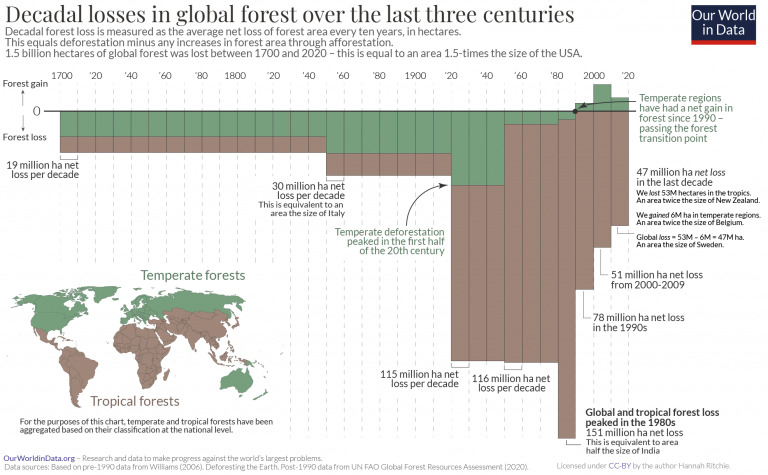Billions of people in the world are living in poverty. Adjusted for the purchasing power in each country, 85% of the world population live on less than $30 per day.
In an earlier post I said that ‘if we want global poverty to decline substantially then the economies that are home to the poorest billions of people need to grow.’ In this post I want to make this statement more concrete. I will look at the depth of global poverty today to get a quantitative sense of just how much the global income distribution would need to change to reduce global poverty substantially.
As a starting point for the discussion I will consider the inequality of incomes in the world today and think through a scenario that would allow the maximal reduction of global poverty under minimal global aggregate income growth. After calculating the minimum aggregate growth that is required to reduce global poverty substantially I will consider in which ways a possible more realistic scenario of the future might differ from the minimum scenario. Even the minimum growth scenario is one of very large economic growth.
The reason that such large economic growth is necessary to reduce global poverty is that the world is still very poor. I think that those who don’t see the importance of growth are not aware of the extent of global poverty. Being poor means that people do not have access to the goods and services that they need. As we will see, the reason for this is partly the large inequality, but it is also due to the fact that these goods and services are simply not produced – increasing the production of the goods and services that people want, this is what economic growth is.1
In another earlier text I asked who is considered poor in a high-income country. Based on existing national poverty lines – but also the size of social care payouts, a proposal for Universal Basic Income, and survey results – I found that $30 per day is, very approximately, the level below which people are considered poor in high-income countries.
One of the most important insights of economics is that people live in poverty not because of who they are, but because of where they are. A person’s knowledge, their skills, and how hard they work all matter for whether they are poor or not – but all these personal factors together matter less than the one factor that is entirely outside of a person’s control: whether they happen to be born into a large, productive economy or not.
The comparison of a high-income country like Denmark and a much poorer country like Ethiopia makes clear just how important this aspect is. A person living in Denmark has a chance of 86% that they are not poor. A person who happens to be born into a country where the average income is low is almost certainly living in poverty. In Ethiopia more than 99% of the population live on less than $30 per day. This is why a rise in the average level of income in a country – economic growth – is so crucial for reducing poverty.

Throughout this entire text all poverty statistics are adjusted for differences in purchasing power across different countries. Without taking into account the price differences it is not possible to compare people’s living standards in different countries. See the footnote for a more detailed explanation of how poverty is measured.2
This large visualization here shows the same comparison that we have just seen for Denmark and Ethiopia, but now for countries around the world. In purple you see the share of each country’s population living on less than $30 per day.
I ordered the countries by income: from the poorest countries on the very left of this chart to the richest countries on the right. The width of each country corresponds to the country’s population size.
This visualization shows the extent of global poverty today. The huge majority of the world lives in countries where the majority is poor. As you can read above this chart, 77% of the world population live in countries in which more than 90% live on less than $30 per day.3
→ Daniel Bachler built an interactive visualization of this chart in which you can set any poverty line you might be interested in.
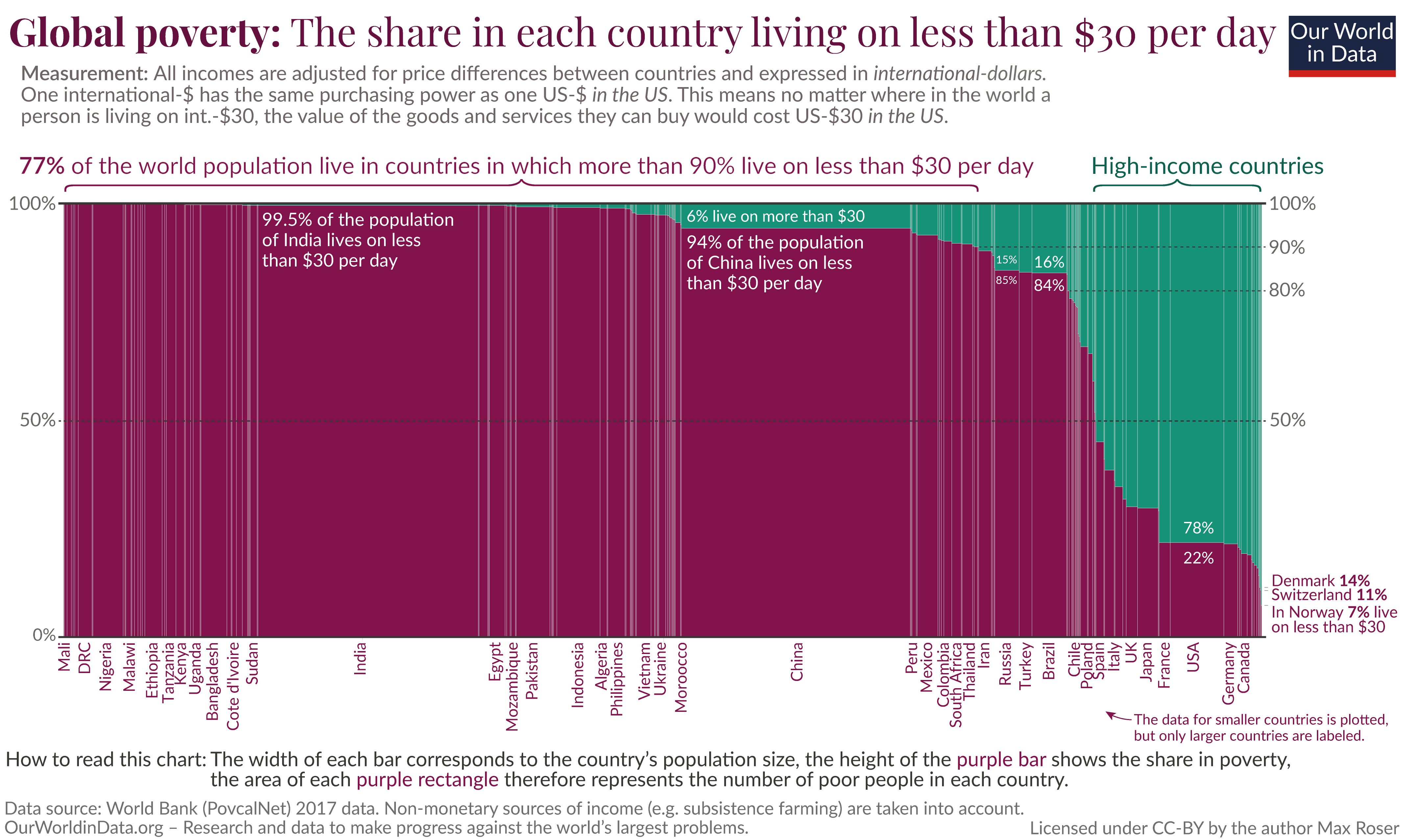
Poverty is not inevitable
In the past it was unimaginable that it would ever be possible to reduce poverty.4 In a world in which every second child died and where hunger was widespread, the majority of people lived in poverty. And since poverty did not change, it was easy to believe that poverty was unchangeable.
Today we know that this was wrong, we know that poverty is not inevitable because poverty has declined very substantially in many countries. The population of Denmark was once as poor as the population of Ethiopia today, but since then poverty declined and living conditions improved: average incomes increased more than 25-fold, the child mortality rate declined from more than a quarter to less than half a percent – one of the lowest levels in the world – and Denmark is today one of the countries where people report to be most satisfied with their lives.
As such I will use Denmark as a benchmark of what it means for poverty to fall ‘substantially’. Using Denmark as a benchmark, we can ask: how equal and rich would countries around the world need to become for global poverty to be similarly low as in Denmark?
Denmark is not the only country with a small share living on less than $30, as the visualization above showed. In Norway and Switzerland an even smaller share of the population (7% and 11%) is living in such poverty. I chose Denmark, where 14% live in poverty, as a benchmark because the country is achieving this low poverty rate despite having a substantially lower average income than Switzerland or Norway.
Considering a scenario in which global poverty declines to the level of poverty in Denmark is a more modest scenario than one that considers an end of global poverty altogether. It is a scenario in which global poverty would fall from 85% to 14% and so it would certainly mean a substantial reduction of poverty.
If you think that my poverty line of $30 per day is too low or too high, or if you want to rely on a different country than Denmark as a benchmark, or if you would prefer a scenario in which no one in the world would remain in poverty, you can follow my methodology and replace my numbers with yours.5 What I want to do in this text is to give an idea of the magnitude of the changes that are necessary to substantially reduce global poverty.
The previous chart showed that in the majority of the world’s countries the vast majority lives on less than $30 per day. The following chart zooms in from the global view of the previous chart to a more detailed comparison of just two countries: our benchmark country Denmark in red and Ethiopia in blue.
There is no global survey of incomes: researchers need to rely on the available national surveys. Such surveys are designed with cross-country comparability in mind, but because they reflect the circumstances and priorities of individual countries there are some important differences across countries. In most richer countries the surveys capture people’s incomes, while in poorer countries these surveys capture people’s consumption. The two concepts are closely related: the income of a household equals their consumption plus any saving (or minus any borrowing).6 When speaking about these statistics it would therefore be accurate to speak about ‘the income of people in richer countries and the monetary value of consumption in poorer countries’. But since it’d be a bit much to repeat this every time researchers simply speak of ‘living standards’ or ‘income’ instead. I do the same in this text.
It’s also important to remember that in poorer countries many work as subsistence farmers who do not, or only partly, rely on a monetary income. To properly capture their living standards, and allow comparisons between households, the statisticians who conduct the household surveys include an estimate of the monetary value of the food and other goods that they produce for their own consumption.7
What does the chart tell us about living standards in these two countries?
If we want to know how much the distribution of Ethiopia would need to change to reduce the share in poverty to Denmark’s level we can read it off the two parameters that describe the distribution – the average level of income and the inequality of those incomes.
Ethiopia has a much lower average income: an increase of average incomes is called economic growth and to increase the average from $3.30 per day to $55 would mean that Ethiopia would need to increase its income 16.7-fold (because $55 is 16.7-times higher than $3.30).8
Inequality is also higher in Ethiopia. To reach the same level of poverty at the same level of average income the Gini would have to fall by 5 points. But the current average is so far below $30 a day that without economic growth no amount of redistribution would lower the poverty rate relative to this threshold.9
A more than 16-fold increase in average incomes is certainly not easy to achieve, but it is also not impossible. The average income in Denmark grew by more than that over the last few generations, and such growth is not rare in recent economic history.
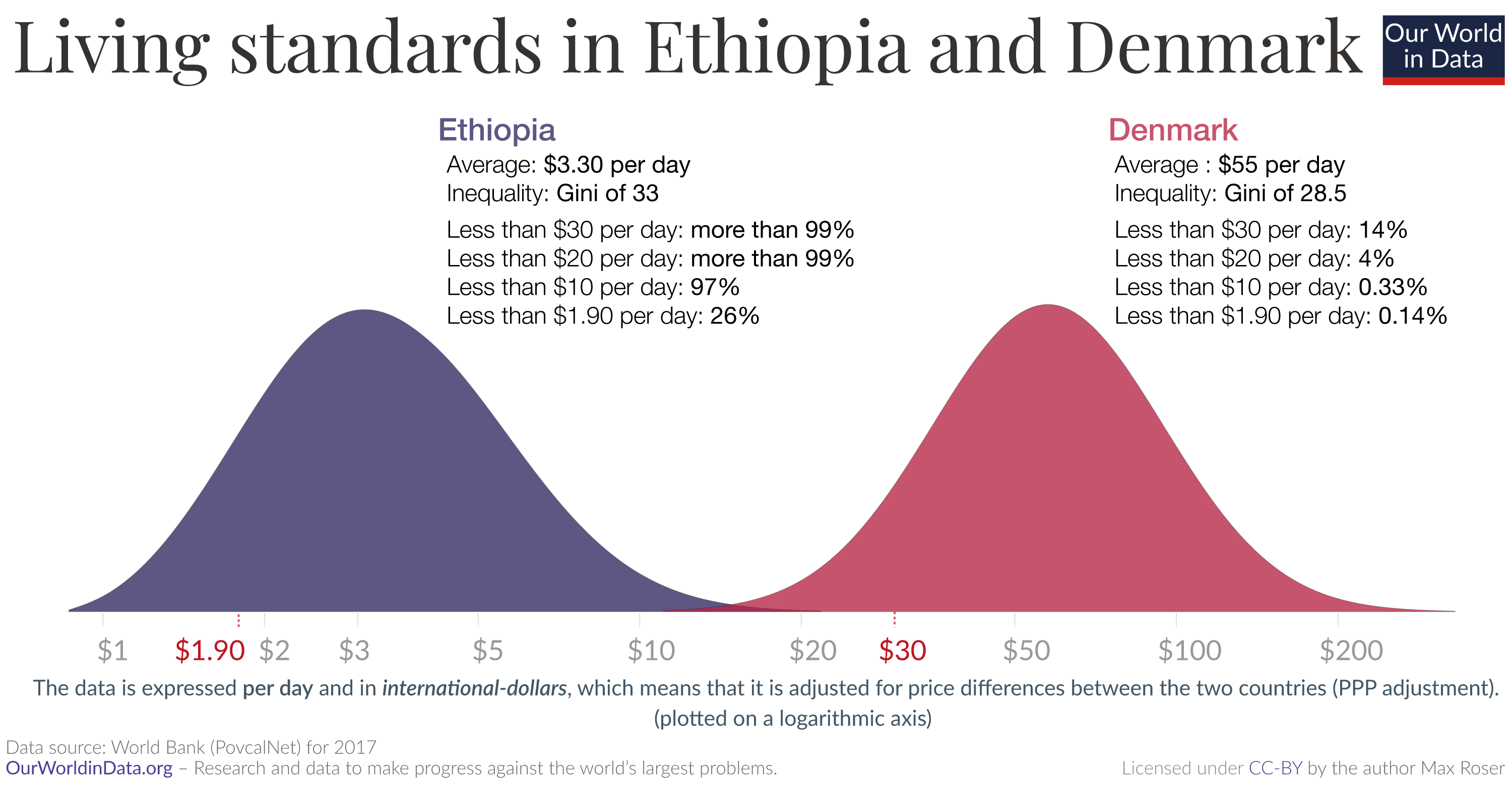
We have seen that the average income in Ethiopia is 16.7-times lower than the average in Denmark. How do the incomes of people in all other countries in the world compare with Denmark?
The chart here shows us the answer by plotting the average incomes for all countries in the world. The height of each bar represents the average daily income in a country; the width of each country again corresponds to the country’s population size and again I have ordered the countries by income: from the poorest country on the very left to the richest country on the very right.
The reason why such substantial economic growth is necessary for reducing global poverty is that the average income in many countries in the world is very low: 82% of the world population live in countries where the mean income is less than $20 per day.
Denmark is highlighted in green. With an average income of $55 per day it is among the richest countries in the world, though there are several countries where average incomes are higher still.
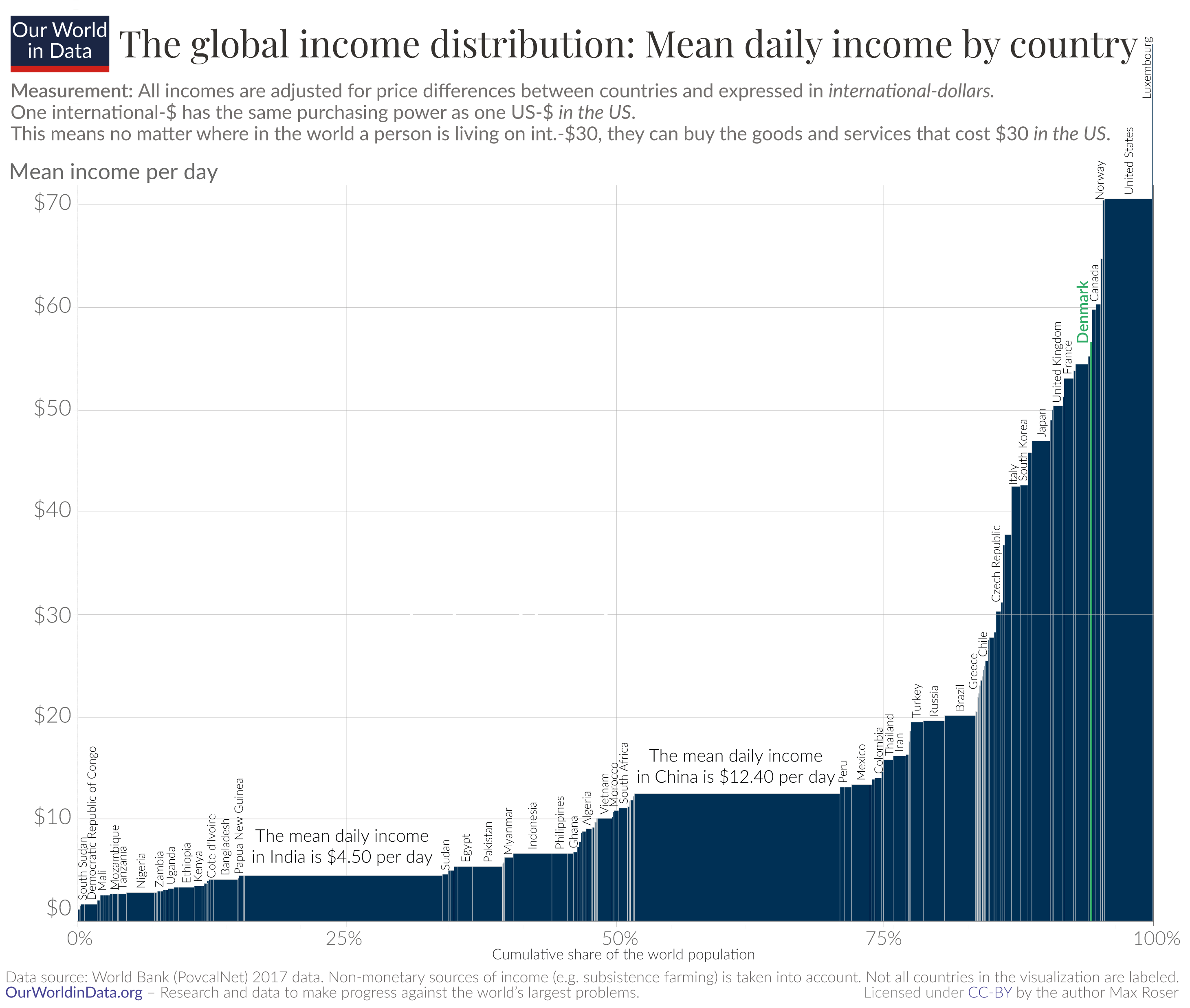
This next chart is based directly on the previous one and shows for every country by how much the mean income would need to increase to reach Denmark’s mean income.
I rotated the orientation of this chart so that now the height of each bar is proportional to the size of that country’s population. The population size is relevant because we need to take into account each country’s share in world population, and expected future population growth, in order to calculate the minimum necessary global aggregate growth that is required to reduce poverty.
The chart shows that Ethiopia is among the poorer countries and, as we have seen above, its average income would need to increase 16.7-fold to reach Denmark’s. The countries that have a lower average income than Ethiopia need higher economic growth to reach the level of Denmark; the countries that are already richer than Ethiopia require less.
The very richest countries don’t need additional growth to reach Denmark, they are already richer. If they would achieve a reduction of inequality they could reduce the share of their population living on less than $30 per day to the level of Denmark. Those countries I have shown in red and for the calculation of the minimum necessary global growth I assumed that these countries reduce the average income of the people that live there.
The simple idea of this hypothetical scenario is that every country that is poorer than Denmark increases average incomes to the level of Denmark and every country that is richer decreases the income of the people in those countries. And in addition to this every country in the world reduces its income inequality to the low level of Denmark.
How much growth would be needed in total?
You find the calculation in the footnote. The minimum necessary growth to reduce global poverty to the level of poverty in Denmark is 410%.10
An increase by 100% would mean that the size of the economy would double. A 410% increase is therefore a 5.1-fold increase of the global economy.
Or put differently, a world economy with substantially less poverty is at a minimum 5-times bigger than today’s global economy.
A five-fold increase is a minimum estimate of the economic growth that is necessary to reduce global poverty substantially. In the following box I discuss in which ways a more realistic expectation of what the future might look like would imply larger economic growth.
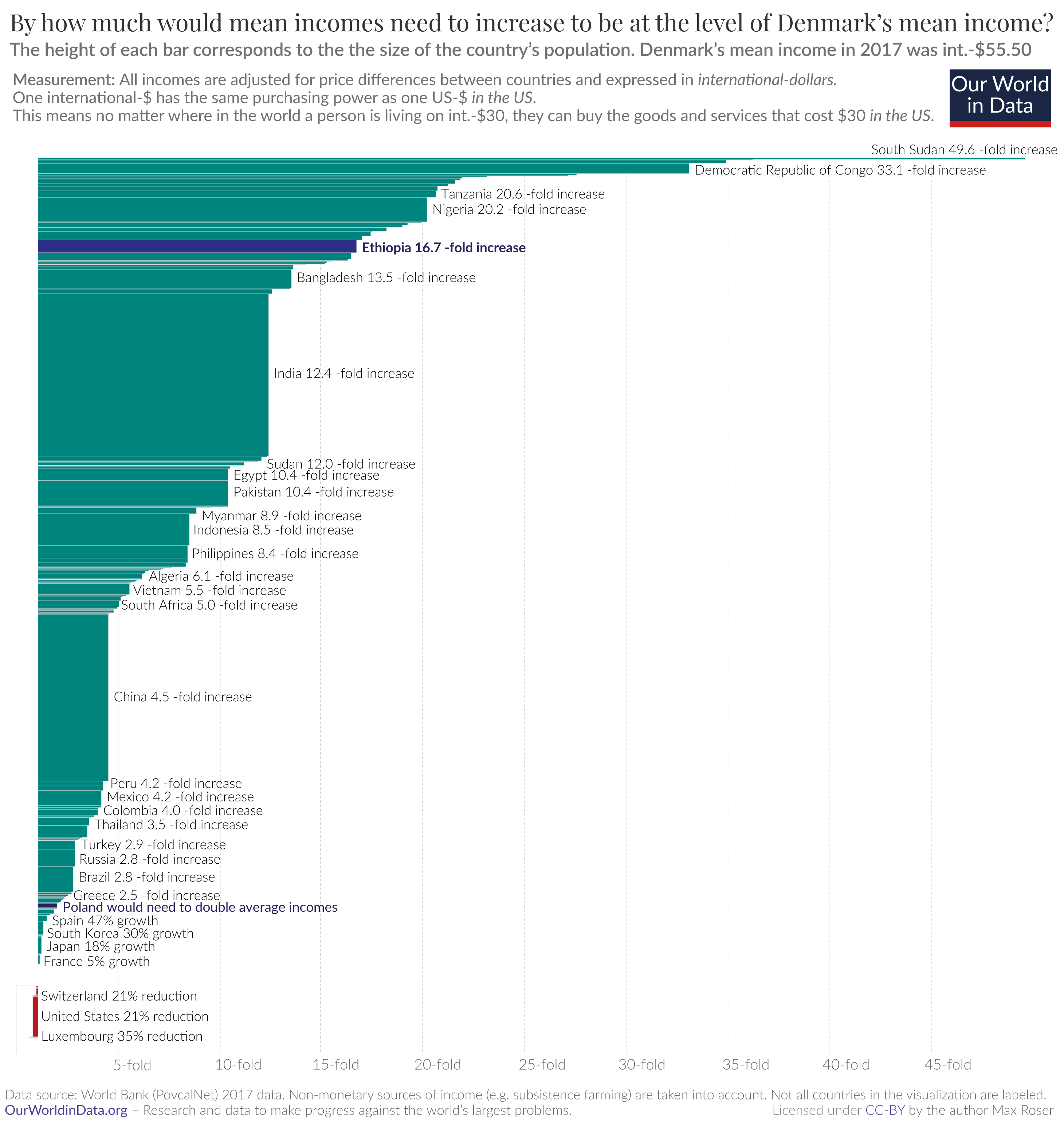
In which ways does a realistic scenario differ from the minimum scenario?
To calculate the minimum growth that is necessary one has to rely on a scenario that would allow the maximal reduction of global poverty under minimal growth. This is what I did in the previous section.
The result of this calculation is that the total size of the global economy would need to be more than 5-times larger than currently to substantially decrease global poverty.
A minimum growth scenario for poverty reduction of course implies much lower economic growth than any realistic scenario of how the future global economy might look like. It therefore makes sense to consider in which ways a more realistic scenario would imply more economic growth than this minimum scenario.
In this scenario every country stops economic growth entirely once they reach the average income of Denmark
This calculation is based on a scenario in which every country stops economic growth once they reach the level of Denmark. The chart just above shows this: After additional economic growth of 30% South Korea would reach the average income of Denmark and in this scenario it would stop exactly there. Russia would grow until incomes are 2.8-fold higher than now and stop then. And the same is assumed for all other countries in this scenario.
The reason I went with this assumption for this scenario is to calculate the minimum growth needed to substantially reduce global poverty. Of course there is no reason to expect that countries would actually do this, which means that global economic growth would be higher before global poverty is substantially reduced.
In this scenario every country that is richer than Denmark reduces average incomes
To calculate the minimum necessary aggregate growth I assumed that the countries that are richer than Denmark would shrink their economies so that people’s incomes there would decline.11 Again, this is helpful to see the minimum growth needed, but since there is no reason to expect that countries would actually do this we should expect more economic growth before global poverty is substantially reduced.
As a consequence there is no global inequality between countries in this scenario
The consequence of the previous two features of this scenario is that global inequality between countries disappears entirely: every country in the world would have an average income of $55 per day.
You have to be extremely optimistic about the future of inequality to think this is likely. If you don’t think this will happen, then the economic growth that the world will see before any possible substantial reduction of global poverty will be higher.
In a scenario in which countries do not decrease average incomes of the population and in which average incomes of all countries increase at a rate of 2% per year, the global economy would be 7.2-times larger.12
In this scenario inequality within countries declines very substantially
The scenario assumes a massive reduction of inequality within many countries. Denmark is one of the most equal countries in the world today (see this map) so that almost all countries in the world would need to achieve large reductions of within-country inequality to reach a poverty headcount ratio as low as Denmark on an average income of $55. Since there is no inequality between countries in this scenario it is implied that the world as a whole achieves the same inequality of incomes as Denmark today.
In many countries around the world inequality did decrease over the past generation and this might give us some confidence that further reductions of inequality are indeed possible. But you need to be extremely optimistic about the future of inequality to believe that all countries will achieve the very low inequality of Denmark. Again, I assumed it here to calculate the minimum growth necessary. If you believe that this scenario is not realistic then the implication is that the necessary economic growth to reduce global poverty will in reality be higher.
An even more optimistic scenario would be to expect that perfect equality between every single person in the world could be achieved. The richest person in the world would live on $30 per day – just above the poverty line – and the poorest person too. Even then very substantial economic growth would be needed to end global poverty: the world economy would need to more than double.13
This scenario is based on Denmark rather than the richer countries where a smaller share of the population live in poverty today
In this scenario I have based all calculations on Denmark. The country that actually has the lowest share of the population living in poverty is Norway, a country that is substantially richer than Denmark. Calculating the growth required for every country in the world to reach the average income of Norway would therefore yield higher necessary minimum growth.
The required economic growth in GDP terms will be higher than in household income terms
None of the discussion and none of the calculations here relied on GDP per capita. The average incomes reported throughout this post are based on what people report in household surveys. GDP per capita is the more commonly used measure of average incomes as it is a more comprehensive measure of people’s incomes – importantly GDP per capita includes government expenditure (for more background on the differences see footnote 24 of this post).
The differences between these two average income measures matter for the calculation of the necessary minimum growth. The gap between average incomes as determined in household surveys and GDP per capita typically increases with rising income, which means that if we would consider the necessary minimum growth in GDP terms rather than household income terms the required growth would be larger.
It would not be the end of poverty – only a substantial reduction of poverty
And lastly keep in mind that this is a scenario in which there will still be people in poverty. Poverty is lower in Denmark than in much of the rest of the world, but it is nevertheless a large problem in Denmark. In the scenario here the same would be true for the world. Global poverty would be reduced very substantially, but it will nevertheless be a world in which 14% of the population live on less than $30 per day.
How much does future population growth matter?
In the calculations here I relied on the most widely used demographic projection of future population growth, the UN Population Division’s mid-variant projections. There are other projections and it makes sense to consider how different demographic scenarios would impact the calculations, in particular because the demographic research literature suggests that increases in incomes would lead to a decline of fertility rates.
On the other hand it is important to not overstate the possible impact of these changes. The number of children in the world is already close to the peak and much of the future population growth is due to ‘population momentum’.
In our entry on future population growth we discuss several global population projections, those who expect lower population growth expect a world population that is about 18-20% smaller than the UN mid-variant. Accordingly the minimum size of total incomes would therefore need to be about 18-20% lower under a lower population growth scenario.
Is it enough to reduce poverty?
This scenario here is envisaging the necessary changes to reduce poverty. A reduction of poverty is an important goal, but it is surely not the only goal a society might have, the ambition is not to lift everyone’s living standards just above the poverty line. The question of what living standards make a person or a household well off is an important one, but it is beyond the considerations in this text.14
My takeaway
The purpose of this scenario was to calculate the minimum necessary growth. I’m cautiously optimistic about the possibility that global income inequality declines further, but I’m not as optimistic as this minimum scenario envisages and I therefore think that if the world will ever substantially reduce poverty then it would be a future with more aggregate global economic growth than a 5-fold increase.
Reducing global poverty is not the only important global goal. It will also be crucial to reduce humanity’s very large impact on the environment. Yes, it will be very hard to achieve both goals at the same time and we should be clear about how difficult this challenge is.
This challenge comes down to the question of whether it will be possible to decouple economic growth from environmental harm and then achieve the transition to a sustainable production of the goods and services that people need:
- If those who say that it is not possible to decouple growth from environmental harm are right, then the future will be bleak. If indeed there should be no possibility to sufficiently decouple growth from environmental impacts then the future will will be either one of continuing global poverty or one of continuing environmental destruction, or both.
- If however we want to achieve a future in which global poverty is substantially lower than today and in which humanity has a smaller negative impact on the environment, then it will be necessary to decouple growth from environmental impacts and achieve a sustainable production of the products we all need.
In the last years many countries have reduced negative environmental impacts while production and incomes increased. Many European countries have reduced consumption-adjusted CO₂ emissions while incomes increased. Global emissions of ozone-depleting substances have declined by more than 99% in the last three decades. And global deforestation rates have declined strongly since the 1980s. But many large environmental problems remain and greenhouse gas emissions caused by the world’s richest people are much higher than those caused by poorer people. No country has achieved a sustainable production of the goods and services that people need, a major reason for this is the world’s energy problem.
I do not know whether humanity will be successful in leaving poverty behind, while substantially reducing its environmental impact. The future is not yet written. But this also means it is up to us now to do what we can to make a future of much less environmental harm and less poverty possible. Much of our work here at Our World in Data is therefore dedicated to studying how it might be possible to achieve a future in which an increasing share of humanity is less poor and in which humanity has a smaller negative environmental impact – we document what we know about global poverty and humanity’s impact on the environment and consider possible solutions for how to decrease global poverty while reducing environmental harm (some of the texts you might be interested in, in this regard: 1, 2, 3, 4, 5, 6, 7, 8, 9, 10, 11, 12, 13 and many more).
As you will see in our writing there are several important cases in which an increased consumption of specific products gets into unavoidable conflict with important environmental goals; in such cases we aim to emphasize that we all as individuals, but also entire societies, should strongly consider to reduce the consumption of these products – and thereby reduce the use of specific resources and forgo some economic growth – to achieve these environmental goals. We believe a clear understanding of which specific reductions in production and consumption are necessary to reduce our impact on the environment is a much more forceful approach to reducing environmental harm than an unspecific opposition to economic growth in general.
We should also emphasize when the two goals are not in conflict with each other. Some, for example, believe that the decarbonisation of our economies conflicts with economic growth.15 But this is no longer the mainstream view. The latest annual IMF report estimates that policies, including carbon pricing, that mitigate climate change actually increase economic growth over the coming decades. 16 This means that there is no trade-off between fighting climate change and economic growth. Fighting climate change is a way to achieve more growth.17 Fighting climate change is not just compatible with fighting poverty, the two goals — to reduce emissions and to increase economic growth — actually strengthen each other.
And when important goals are in conflict with each other we should be clear about the immense difficulty of the challenge. In those cases it is certainly not helpful and actually harmful to pretend that there are easy ways out. Pretending that it is possible to reduce global poverty without large aggregate growth would leave us entirely unprepared to meet the difficult challenge that we actually face, a reduction of environmental harm while also reducing global poverty.
Before discussing the possibilities for future growth I also want to stress that the level of economic inequality matters for the reduction of poverty. We saw this in the data above: the average income in the US is higher than in Denmark, yet because these incomes are much less equally distributed there is a higher share of Americans living in poverty.
But whether or not global poverty can possibly decline that much – from the current level of 85% to Denmark’s level of 14% – overwhelmingly depends on whether the average incomes in those countries that are home to the poorest billions of people in the world will increase or not.
One reason why you might want to consider that this is possible is the reality of those countries in which the majority left poverty behind in recent decades. As we have seen before, even a country like Denmark was extremely poor until recently and there is no reason to believe that the productivity increases that made economic growth in Denmark possible should not be possible elsewhere.
Another reason to think that many countries in the world can make progress against poverty in the future is to consider some of the reasons that were holding these countries back in the past. One important reason why a large number of people live in poverty today is that these countries were exploited by colonial powers that did not allow those economies to grow and instead impoverished them. The actions of rich countries still harm the prospects of poorer countries in many ways, but the end of colonialism was extremely important for the prospects of billions of people in the world and since the end of colonial rule many former colonies did substantially reduce poverty.
A third aspect to consider is that countries around the world saw large improvements in health and education in recent years. Health and education do not automatically translate into higher prosperity, but surely make it more likely that a country can leave poverty behind.
A fourth reason is to see that ’catch-up growth’ can be very fast: several countries have achieved annual growth rates of more than 5% in recent decades.
And a last reason to consider is that up to the pandemic the majority of countries in the world – but not all – did make progress against poverty. Global poverty has declined very substantially in recent decades, no matter what poverty line you want to draw.
Increasing productivity substantially and reducing humanity’s impact on the environment are certainly not easy, but these are some of the points to consider when thinking about the question of whether it might be possible to make progress towards these two goals.
What this post has shown is that if you consider a person who lives on less than $30 per day to be poor, then the extent of poverty in our world today requires very large global aggregate growth to substantially reduce global poverty.
Personally I certainly believe that a person who lives on less than $30 per day is poor and I believe it is unjust that in most countries in the world the majority lives in such poverty. This is why I believe that the economies that are home to the poorest billions of people need to grow if we want global poverty to decline substantially.
If you are opposed to global economic growth for one reason or another, then I hope this post is helpful in considering the implications of this opposition.
Acknowledgement: I would like to thank Joe Hasell for his thoughtful comments on draft versions of this article.
Continue reading Our World in Data:
